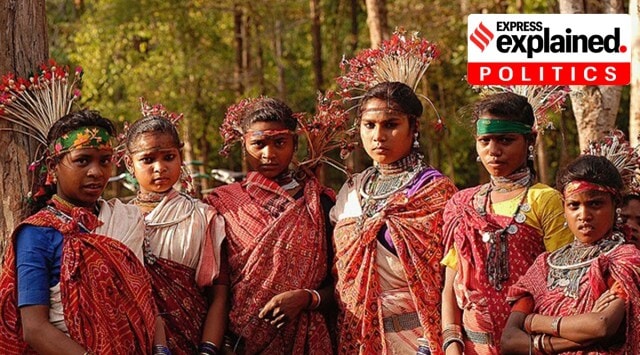Baiga tribal group gets habitat rights in Chhattisgarh: What this means, significance
Habitat rights are given to Particularly Vulnerable Tribal Groups (PVTG) under the Forest Rights Act. Who are PVTGs? How do the habitat rights help them?
 A total of 19 Baiga villages with a population of 6,483 people have been given habitat rights. (Photo: Wikimedia Commons)
A total of 19 Baiga villages with a population of 6,483 people have been given habitat rights. (Photo: Wikimedia Commons) Ahead of Assembly elections in Chhattisgarh, the Baiga Particularly Vulnerable Tribal Group (PVTG) Monday became the second to get habitat rights in the state, after the Kamar PVTG on August 9.
A total of 19 Baiga villages with a population of 6,483 people (2,085 families) have been given the habitat rights. These villages/para/tola of Gaurela block received the rights in a special event organised by the district administration of Gaurela-Pendra-Marwahi (GPM).
The Baiga community primarily resides in Rajnandgaon, Kawardha, Mungeli, Gaurela-Pendra-Marwahi (GPM), Manendra-Bharatpur-Chirmiri, and Bilaspur districts of the state. The community also lives in the adjacent districts of Madhya Pradesh.
What are habitat rights?
Habitat rights recognition provides the community concerned rights over their customary territory of habitation, socio-cultural practices, economic and livelihood means, intellectual knowledge of biodiversity and ecology, traditional knowledge of use of natural resources, as well as protection and conservation of their natural and cultural heritage.
Habitat rights safeguard and promote traditional livelihood and ecological knowledge passed down through generations. They also help converge different government schemes and initiatives from various departments to empower PVTG communities to develop their habitats.
What does ‘habitat’ mean, under what law are such rights granted?
Habitat rights are given to PVTGs under section 3(1) (e) [rights including community tenures of habitat and habitation for primitive tribal groups and pre-agricultural communities] of The Scheduled Tribes and Other Traditional Forest Dwellers (Recognition of Forest Rights) Act, 2006 also known as the Forest Rights Act (FRA).
According to Section 2(h) of FRA, “Habitat includes the area comprising the customary habitat and such other habitats in reserved forests and protected forests of primitive tribal groups and pre-agricultural communities and other forest dwelling Scheduled Tribes.”
Can habitat rights be used to stop activities like mining?
Shomona Khanna, an advocate at the Supreme Court of India and former legal advisor to the Union Ministry of Tribal Affairs, said, “Of course, the habitat rights will help the PVTG protect their habitat from developmental activities harmful to them. The title may not be an ownership title in the nature of a private property owner, but consent and consultation of the gram sabha will be needed for any developmental activity. Forest Rights have legal protection under the Forest Conservation Act, the Land Acquisition law of 2013, and even the SC/ST Prevention of Atrocities. Act. Grant of habitat rights under the Forest Rights Act provide an additional layer of legal protection.”
If any kind of development activity is hampering their habitat rights, the tribal group concerned can take up the matter with the administration under the Forest Rights Act, and if not resolved, the matter can be taken to court.
Which tribes are termed PVTG?
According to the ministry of tribal affairs, tribal communities who are technologically backward, who have stagnant or declining population growth, extremely low level of literacy, and a subsistence level of economy are declared as PVTG. PVTGs have low health indices and largely reside in isolated, remote, and difficult areas in small and scattered hamlets/habitats.
The ministry has identified 75 PVGTs in 18 states and one Union Territory. In 2019, the MoTA started a scheme for their protection and improvement in terms of social indicators like livelihood, health, nutrition and education to decrease their vulnerability.
How many states have recognised habitat rights?
Out of 75 PVTG in India, only three have habitat rights. The Bharia PVTG in Madhya Pradesh was the first, followed by the Kamar tribe and now the Baiga tribe in Chhattisgarh.
How many PVTGs does Chhattisgarh have?
There are seven PVTGs in Chhattisgarh, who live in 17 of the state’s 33 districts. These are Kamar, Baiga, Pahadi Korba, Abujhmadiya, Birhor, Pando and Bhujia. The total population of PVTG tribes in Chhattisgarh as per the 2015-2016 survey is 2.50 lakh while the population of tribals in Chhattisgarh as per the 2011 census is 78.22 lakh.
While the first five tribes have been declared PVTG by the central government, the remaining two, Pando and Bhujia, have been given the tag by the state government.
The seven tribes by population are Kamar tribe with 26,622 people, Abujhmadiya tribe with 23,330 people, Baigas with 88,317 people, Pahadi Korba with 44,026, Birhor with 3490 people, Pando with 32,000 people and Bhujia with 8,000 people, as per information provided by IAS Shammi Abidi, commissioner for Scheduled Tribe & Scheduled Caste Development Department.
How does the government fix a habitat?
Bibhore Kumar Deo, project head at United Nations Development Program (UNDP) which is providing technical assistance to the administration to implement the habitat rights law, said the procedure is based on a detailed guideline given for this purpose in 2014 by the MoTA.
Four state-level departments — Forest, Revenue, Tribal and Panchayati Raj — are coordinating with the UNDP team to ascertain what can be termed as habitat. “Based on the MoTA guidelines, the traditional tribal leaders of the tribe are consulted about the extent of their culture, traditions, occupation. It is corroborated by the government and then a habitat is declared,” said Deo.
When did the procedure of giving habitat rights to PVGTs begin in Chhattisgarh?
As per sources, the first consultation for giving these rights began in December 2021. As a pilot project, the government began with Kamar tribes. “It is a long, tedious procedure. But after the pilot project, this procedure can go faster. The PVTGs are introverts and reserved. It is quite a task to build a rapport and get them to respond. They live in their own world; they are happy with leading a very basic lifestyle,” said Deo.
How many Kamar tribes have got habitat rights so far?
Kamar tribes have a population of 26, 622 in four districts. Till now, 22 Para/Tola (hamlets) with a population of around 2,500 people from Magarlod sub region of Magarlod development block in Dhamtari district have got it. Also, out of the 88,317 Baiga tribes, 6,483 have got it.



- 01
- 02
- 03
- 04
- 05



































